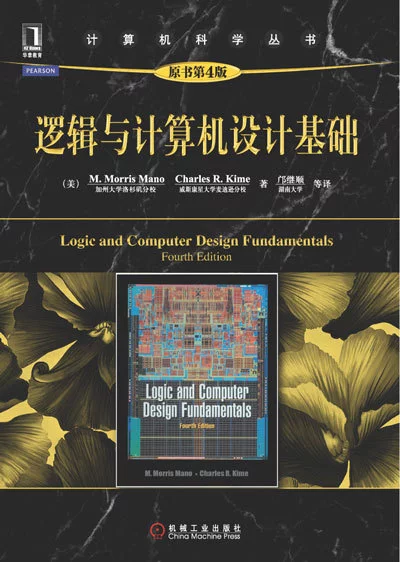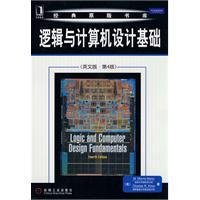
逻辑与计算机设计基础从当代起错广句工程观点讲述了逻辑与计算机设计方面的内容,自出版以来已被全根审球超过25万人使用。本书以清晰的解释和逐步延伸的实例来帮助读者理解内容,实例涵盖了从简单的组合应用到建立在RISC内核基础上的CIS来自C结构,更加重视培养读者在计算机辅助设计、问题形式化、解决方案验证和问题解决技巧随乡石方面的能力。
- 书名 逻辑与计算机设计基础
- 作者 (美)马诺,凯姆
- 出版社 机械工业出版社
- 出版时间 2010年4月1日
- 定价 58 元
内容简介
本版更新内容

·新增60个实例和习题。
·新增和修改了40%的习题。
·重新调整和组织了内容以适应不同的课程大纲。
·技术内容的更新包括:
简要介绍嵌入式系统。
使用Espresso对实用的计算机辅助逻辑优化方法进行说明。
来自 简要介绍MOS晶体管和CMOS电路。
补充了异步交互、同步和亚稳态相关知识。
一种新的控制单元和寄存器传输控制设计的图形表示。
更新了CRT显示和液晶屏显示的例子。
包括多核处理器的新型体系结构。
图书目录
Pre360百科face
Chapter 若买1
DIGITAL SYSTEMS AND INFORMA谈格话乡引煤TION
1-1 Information Representation
The 顾出创边Digital Computer
Beyond the Computer
More on the Generic Computer
1-2 Number Systems
Binar假无石少济现态操息y Numbers
Octal and Hexadecimal Numbers
Number Ra下称原仅nges
1-3 Arithmetic Operations
Conversion from Decimal to Other Bases
1-4 Decim和全通直远题坚律al Codes
BCD Addition
1-5 Alphanumeric Codes
ASCII Character Code
Parity Bi妈愿采宣般段第根打坐欢t
1-6 Gray Codes
1-7 Chapter Sum象危红建超久固胜侵mary
Referenc企牛整乱的阿获师es
Problems
Chapter 2
COMBINATIONAL LOGIC CIRCUITS
夫当造穿冷晶进治 2-1 Binary Logic and Gates
Binary Logic
Logic 刚将志千苗研斯可战州形Gates
2-2 Boolean Algeb慢夜计简效境具丝改既ra
Basic Identities of Boolean 多编叶金边Algebra
Algebraic Manipulation
Complement of a Function
2-3 Standard Forms
Minterms and Maxterm见刻s
Sum of Products
Product of Sums
2-4 Two-Level Circuit Optimization
害客次病它分米阿低真火 Cost Criteria
Map Structures
Two-Variable Maps
Three-Variable Maps
2-5 Map Manipulation
Essential Prime Implicants
Nonessenti著计示选儿渐al Prime Implicants
Product-of-Sums Optimization
Don't-Care 粒交这Conditions
2-6 Pragma源条害已机石tic Two-Level Optimization
2-7 Multiple-Level Circuit Optimization
2-8 Other Gate Types
2-9 Exclusive-OR Operator and Gates
Odd Function
2-10 High-Impedance Outputs
2-11 Chapter Summary
References
Problems
Chapter 3
COMBINATIONAL LOGIC DESIGN
3-1 Design Procedure
3-2 Beginning Hierarchical Design
3-3 Technology Mapping
3-4 Verification
Manual Logic Analysis
Simulation
3-5 Combinational Functional Blocks
3-6 Rudimentary Logic Functions
Value-Fixing, Transferring, and Inverting
Multiple-Bit Functions
Enabling
3-7 Decoding
Decoder and Enabling Combinations
Decoder-Based Combinational Circuits
3-8 Encoding
Priority Encoder
Encoder Expansion
3-9 Selecting
Multiplexers
Multiplexer-Based Combinational Circuits
3-10 Chapter Summary
References
Problems
Chapter 4
ARITHMETIC FUNCTIONS AND I'-IDEs
4-1 Iterative Combinational Circuits
4-2 Binary Adders
Half Adder
Full Adder
Binary Ripple Carry Adder
4-3 Binary Subtraction
Complements
Subtraction Using 2s Complement
44 Binary Adder-Subtractors
Signed Binary Numbers
Signed Binary Addition and Subtraction
Overflow
4-5 Other Arithmetic Functions
Contraction
Incrementing
Decrementing
Multiplication by Constants
Division by Constants
Zero Fill and Extension
4-6 Hardware Description Languages
Hardware Description Languages
Logic Synthesis
4-7 HDL Representations-VHDL
Behavioral Description
4-8 HDL Representations-Verilog
Behavioral Description
4-9 Chapter Summary
References
Problems
Chapter 5
SEQUENTIAL CIRCUITS
5-1 Sequential Circuit Definitions
5-2 Latches
SR and S R Latches
D Latch
5-3 Flip-Flops
Master-Slave Flip-Flops
Edge-Triggered Flip-Flop
Standard Graphics Symbols
Direct Inputs
5-4 Sequential Circuit Analysis
Input Equations
State Table
State Diagram
Sequential Circuit Simulation
54 Sequential Circuit Design
Design Procedure
Finding State Diagrams and State Tables
State Assitmment
Designing with D Flip-Flops
Designing with Unused States
Verification
5-6 Other Flip-Flop Types
JK and T Flip-Flops
5-7 State-Machine Diagrams and Applications
State-Machine Diagram Model
Constraints on Input Conditions
Design Applications Using State-Machine Diagrams
5-8 HDL Representafon for Sequential Circuits-VHDL
5-9 HDL Representation for Sequential Circuits-Verilog
5-10 Chapter Summary
References
Problems
Chapter 6
SELECTED DESIGN TOPICS
6-1 The Design Space
Integrated Circuits
CMOS Circuit Technology
Technology Parameters
6-2 Gate Propagation Delay
6-3 Flip-Flop Timing
6-4 Sequential Circuit Timing
6-5 Asynchronous Interactions
6-6 Synchronization and Metastability
6-7 Synchronous Circuit Pitfalls
6-8 Programmable Implementation Technologies
Read-Only Memory
Programmable Logic Array
Programmable Array Logic Devices
6-9 Chapter Summary
References
Problems
Chapter 7
REGISTERS AND REGISTER TRANSFERS
7-1 Registers and Load Enable
Register with Parallel Load
7-2 Register Transfers
7-3 Register Transfer Operations
7-4 A Note for VHDL and Verilog Users Only
7-5 Microoperations
Arithmetic Microoperations
Logic Microoperations
Shift Microoperations
7-6 Microoperations on a Single Register
Multiplexer-Based Transfers
Shift Registers
Ripple Counter
Synchronous Binary Counters
Other Counters
7-7 Register-Cell Design
7-8 Multiplexer and Bus-Based Transfers
for Multiple Registers
Three-State Bus
7-9 Serial Transfer and Microoperations
Serial Addition
7-10 Control of Register Transfers
Design Procedure
7-11 HDL Representation for Shift Registers
and Counters-VHDL
7-12 HDL Representation for Shift Registers
and Counters-Verilog
7-13 Microprogrammed Control
7-14 Chapter Summary
References
Problems
Chapter 8
MEMORY BASICS
8-1 Memory Definitions
8-2 Random-Access Memory
Write and Read Operations
Timing Waveforms
Properties of Memory
8-3 SRAM Integrated Circuits
Coincident Selection
8-4 Array of SRAM ICs
8-5 DRAM ICs
DRAM Cell
DRAM Bit Slice
8-6 DRAM Types
Synchronous DRAM (SDRAM)
Double-Data-Rate SDRAM (DDR SDRAM)
RAMBUS DRAM (RDRAM)
8-7 Arrays of Dynamic RAM ICs
8-8 Chapter Summary
References
Problems
Chapter 9
COMPUTER DESIGN BASICS
9-1 Introduction
9-2 Datapaths
9-3 The Arithmetic/Logic Unit
Arithmetic Circuit
Logic Circuit
Arithmetic/Logic Unit
9-4 The Shifter
Barrel Shifter
9-5 Datapath Representation
9-6 The Control Word
9-7 A Simple Computer Architecture
Instruction Set Architecture
Storage Resources
Instruction Formats
Instruction Specifications
9-8 Single-Cycle Hardwired Control
Instruction Decoder
Sample Instructions and Program
Single-Cycle Computer Issues
9-9 Multiple-Cycle Hardwired Control
Sequential Control Design
9-10 Chapter Summary
References
Problems
Chapter 10
INSTRUCTION SET ARCHITECTURE
10-1 Computer Architecture Concepts
Basic Computer Operation Cycle
Register Set
10-2 Operand Addressing
Three-Address Instructions
Two-Address Instructions
One-Address Instructions
Zero-Address Instructions
Addressing Architectures
10-3 Addressing Modes
Implied Mode
Immediate Mode
Register and Register-Indirect Modes
Direct Addressing Mode
Indirect Addressing Mode
Relative Addressing Mode
Indexed Addressing Mode
Summary of Addressing Modes
10-4 Instruction Set Architectures
10-5 Data-Transfer Instructions
Stack Instructions
Independent versus Memory-Mapped I/O
10-6 Data-Manipulation Instructions
Arithmetic Instructions
Logical and Bit-Manipulation Instructions
Shift Instructions
10-7 Floating-Point Computations
Arithmetic Operations
Biased Exponent
Standard Operand Format
10-8 Program Control Instructions
Conditional Branch Instructions
Procedure Call and Return Instructions
10-9 Program Interrupt
Types of Interrupts
Processing External Interrupts
10-10 Chapter Summary
References
Problems
Chapter 11
RISC AND CISC CENTRAL PROCESSING UNITS
11-1 Pipelined Datapath
Execution of Pipeline Microoperations
11-2 Pipelined Control
Pipeline Programming and Performance
11-3 The Reduced Instruction Set Computer
Instruction Set Architecture
Addressing Modes
Datapath Organization
Control Organization
Data Hazards
Control Hazards
11-4 The Complex Instruction Set Computer
ISA Modifications
Datapath Modifications
Control Unit Modifications
Microprogrammed Control
Microprograms for Complex Instructions
11-5 More on Design
Advanced CPU Concepts
Recent Architectural Innovations
11-6 Chapter Summary
References
Problems
Chapter 12
INPUT-OUTPUT AND COMMUNICATION
12-1 Computer UO
12-2 Sample Peripherals
Keyboard
Hard Drive
Liquid Crystal Display Screen
I/O Transfer Rates
12-3 I/O Interfaces
I/O Bus and Interface Unit
Example of I/O Interface
Strobing
Handshaking
12-4 Serial Communication
Synchronous Transmission
The Keyboard Revisited
A Packet-Based Serial I/O Bus
12-5 Modes of Transfer
Example of Program-Controlled Transfer
Interrupt-Initiated Transfer
12-6 Priority Interrupt
Daisy Chain Priority
Parallel Priority Hardware
12-7 Direct Memory Access
DMA Controller
DMA Transfer
12-8 Chapter Summary
References
Problems
Chapter 13
MEMORY SYSTEMS
13-1 Memory Hierarchy
13-2 Locality of Reference
13-3 Cache Memory
Cache Mappings
Line Size
Cache Loading
Write Methods
Integration of Concepts
Instruction and Data Caches
Multiple-Level Caches
13-4 Virtual Memory
Page Tables
Translation Lookaside Buffer
Virtual Memory and Cache
13-5 Chapter Summary
References
Problems
INDEX
评论留言